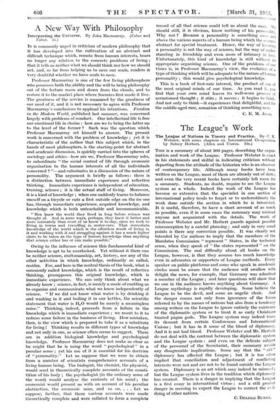The League's Work The League of Nations in Theory and
Practice. By C. K. Webster, with some chapters on International Co-operation by Sidney. Herbert. (Allen and Unwin. 10s.) Tins is a summary of about 300 pages, describing the organ. ization and work of the League. Professor Webster is exact in his statements and skilful in indicating .criticism without departing from the attitude of the historian who is an observer of contemporary life. Although many books have been written on the League, most of them are already out of date ; and even the very recent books have certainly left room for a summary. Students, no doubt, require to see the League system as. a whole. Indeed the work of the League has become so extensive that _ the specialist in one section of international policy tends to forget or to underestimate the work done outside the section _ in which he is interested. It is useful, therefore, to have a short account of as much as possible, even if in some cases the summary may mislead anyone not acquainted with the details. The work of Professor Webster and Mr.' Herbert guards against possible misconception by a careful phrasing ; and only in very small points is there any correction possible. It was clearly not intended by the authors to imply that the members of the Mandates Commission " represent " States, in the technical sense, when they speak of " the states represented " on the Commission. The real difficulty about all books on the League, however, is that they assume too much knowledge even in advocates or supporters of League methods: Every speaker on public platforms and some who speak in academic circles must be aware that the audience will swallow with delight the news, for example, that Germany was admitted a member of the League ; and later questions will show that no one in the audience -knows anything about Germany. A League mythology is rapidly developing. Some believe the League to be the .devil, and some an angelic, choir. And the danger comes.. not only from ignorance of the forces referred to by the names of nations but also from a tendency among writers on the League to ignore entirely the existence of the diplomatic system or to treat it as early Christians treated pagan gods. The League system may indeed trace its descent from certain Conferences and International Unions but' it has in it some of "the blood Of diplomacy. And it is not bad blood. Professor Webster'and Mr. Herbert do not deal with the contrast between the diplomatic system and the. League- sysiein : and even on the 'delicate subject Of the personnel of 'the; Secretariat, their summary avoids any disagreeable implications. Some say that the " old " diplomacy has affected the League ; but it is too often implied that - conciliation and " adjustnient of conflicting interests were not and are not to be found outside the League system. Diplomacy is an art which may indeed be misused ; but the League system lives in the tradition which diplomacy has created. There is a danger in implying that the League is a first essay in international virtue ; and a still' greater danger in seeming to expect the League to correct the evil- doing of other nations.
DELISLE BURNS.








































 Previous page
Previous page